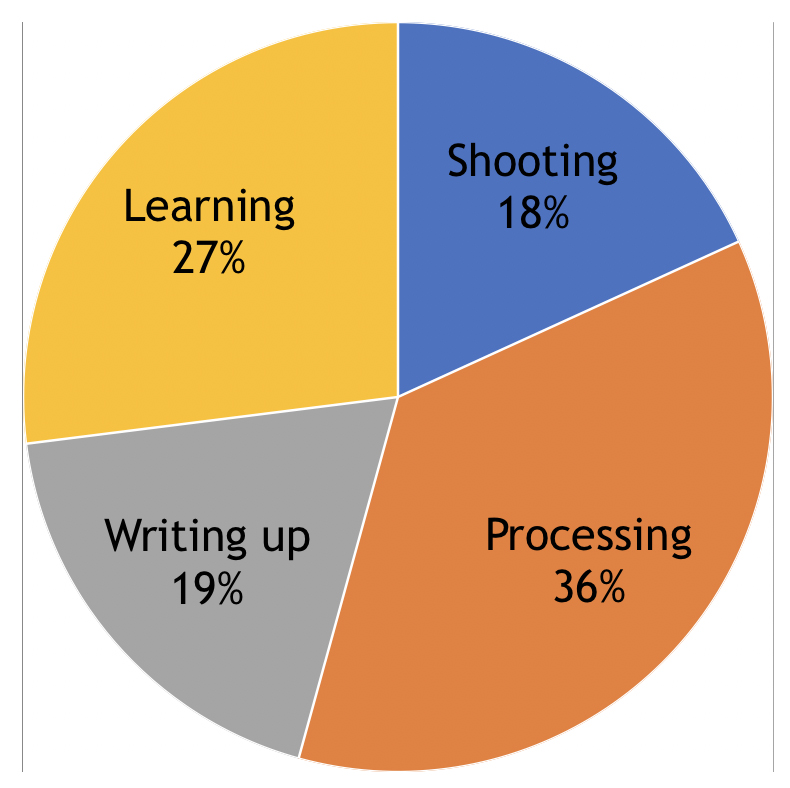
This post reviews how the first 3,000 hours of deliberate practice have been spent against the criteria for becoming more creative (as defined by Mihaly Csikszentmihalyi) and running an effective photographic apprenticeship (as defined by Graham Greene).
What Counts in Each Category
I defined what counts as deliberate practice at the start of this project, which in broad terms is the following 4 categories of activity:
- Shooting; and planning shoots
- Processing: culling, editing in Capture One, Lightroom and Photoshop, and preparing prints
- Writing-up: about photography, including posts for this site and updating social media sites (the later being limited to one hour per day maximum)
- Learning: about art and photography through attending courses, photo clubs, exhibitions and watching YouTube videos.
Project Objective
The goals of this project are to:
- become the best photographer I can be
- test the extent to which 10,000 hours of deliberate practice is sufficient for expertise in the field of photography.
So the issue is: how effective are different activities at improving my photographic skill level?
Achieving the Goal
Mihaly Csikszentmihalyi in his seminal book: “Creativity: the psychology of discovery and invention” defines three key concepts that control creativity. As an apprentice photographer these are easy to identify with:
- Domain: Photography, or in my case, fine art photography which I define as art that someone might want to hang on their wall at home, in a work place or in a gallery
- Field: The ArtWorld as it relates to photography which is the whole structure of judges at club and inter-club competitions and international salons
- Person: “The person who wants to make a creative contribution to a domain must learn the rules and content the domain, as well as the criteria of selection, the preferences of the field.” For me this means studying the history of photography and the assessment of contemporary art.

I find it useful to think of the above as bounding parameters within which I am trying to develop my skill as a photographer. It also gives me a sense of where I have control/ influence and where I do not.
Strategy
Steps to mastery as defined by Robert Greene in his book: “Mastery” together the activity category that I have defined that maps onto each stage and specific activities within each category.

- Observation – close study of the current leaders in the field
- Learning:
- Attending exhibitions
- Attending courses
- Speakers, and discussions with other accomplished photographers, at camera clubs
- Watching YouTubes
- Learning:
- Mimicry – copying the approach of leading practitioners
- Shooting
- Practice
- Processing:
- Copying post processing techniques
- Practicing using Capture One, Lightroom and Photoshop
- Shooting
- Experimentation – combining techniques from different leaders in new ways
- Feedback – response from the field
- Learning:
- Entering competitions at camera clubs, FIAP salons, etc.
- Discussions at Cafe Africa on a Wednesday morning
- Learning:
- Reflection –
- Writing up:
- Completing the daily on-line journal
- Periodic reviews by both season and milestone
- Writing post on specific subjects.
- Writing up:
Trend over Time and Reflection
Over the course of the first 3,000 hours there has been a slight shift of time allocation away from shooting and writing up, towards processing and learning.
In my post “The First 2,500 Hours – Review at 25%“, I expressed anxiety about my lack of photographic style. I think Greene definitely, and Csikszentmihalyi probably, would suggest that this anxiety is ill founded at this stage of my development and I should be spending more time learning and copying the styles of acknowledged masters rather than breaking new ground myself.